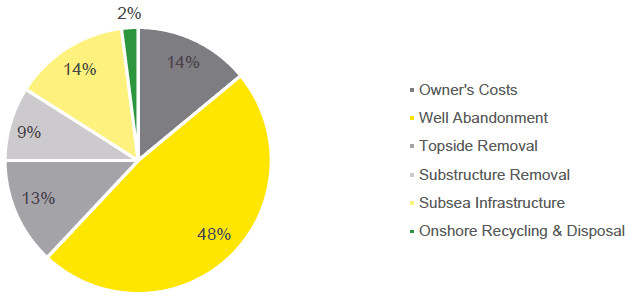Ultra-deep water port: feasibility study
Report compiled by Ernst & Young following their feasibility study looking at the most cost effective locations for an ultra-deep water port in the UK.
3. Decommissioning market
Key Messages
- The overall expected expenditure on UKCS platform decommissioning is estimated at £59.7bn.
- An UDW port would participate in onshore recycling and disposal activities and this is estimated to account for £1.2bn.
- There are three primary decommissioning removal methods for transporting topsides and substructures to ports for onshore recycling and disposal. Only one of these methods, reverse engineer using UHLVs, requires an UDW port.
- Recent UKCS decommissioning projects using UHLVs have been taken to Norway where current ports already have the required water depth requirements.
- Having UDW enhances a port's ability to attract decommissioning projects for onshore recycling and disposal. The UK currently does not have an UDW port.
3.1 Introduction
There are more than 300 oil and gas (O&G) platforms in the UK Continental Shelf (UKCS[3], many of which have reached or are nearing the end of their useful lives. Operators have a legal obligation to decommission the asset unless derogation is granted for it to remain in place. The purpose of this section is to outline the scale of the decommissioning market, the proportion of this that relates to onshore recycling and removal and explain how a specific decommissioning method generates the need for an UDW port.
SG recommended we use the data published by the Oil and Gas Authority (OGA) and OSPAR as our primary sources. Further detail on the decommissioning sector is set out in Appendix D.
3.2 Decommissioning cost forecast
Using operator surveys, the OGA has performed a costing exercise to estimate the total costs of decommissioning across the UKCS[4]. The approach employed captures the high degree of uncertainty in operators' current estimates and outlines an expected total cost of between £44.5bn and £82.7bn, with the OGA using £59.7bn[5] as its base for future cost reduction targets.
Using the information provided by operators, the OGA is able to apportion the expected future costs to different activities in the decommissioning process, as outlined in the figure overleaf.
Figure 1: Decommissioning costs by activity

Source: OGA: UKCS Decommissioning 2017 Cost Estimate Report
Well abandonment is the most significant category of cost, accounting for 48% of expected expenditure. Topside and substructure removal combined account for 21% of expected future costs. Therefore, operators are expected to spend between £9.3bn and £17.3bn in removing platforms from offshore locations to onshore ports.
Onshore recycling and disposal accounts for 2% of expected future decommissioning costs. When considering this within the context of the decommissioning cost estimates provided by the OGA, this amounts to an expected expenditure of between £890m and £1.7bn. According to the OGA's base estimate, the cost of onshore recycling and disposal is forecast to be £1.2bn.
3.3 Decommissioning removal methods
Three decommissioning removal methods of fixed structures are used in the market[6]. These are described in the table below.
Table 3: Decommissioning removal methods
| Method |
Description |
|---|---|
| Piece Small |
|
| Single Lift |
|
| Reverse Engineer |
|
Source: EY Analysis
Of the 28 UKCS platform decommissioning programmes approved by BEIS since 2007[7], reverse engineer has been used in some form in all occasions except two:
- The Janice Floating Production Unit was towed to shore.
- Brent Delta was removed by single lift.
The largest decommissioned structures, located in the NNS and CNS, were all taken to the Norwegian UDW ports (Vats and Stord). The MCP-01 and Miller platforms were taken to Norway as a direct result of the UK not having an UDW port.
None of the reviewed decommissioning projects (those approved by BEIS since 2007) using the S7000 or Thialf used a barge transfer method.
UDW capability is therefore key to attracting projects using this form of removal, particularly when larger platforms are being removed. It allows UHLVs to directly unload modules to the quayside without the need for barge transfer, lowering the risk, cost and timescales of the decommissioning project.
As such, evidence suggests that without an UDW port, it may be challenging for UK businesses to successfully compete with other locations (which have UDW ports) for future large reverse engineer decommissioning projects.
Contact
Email: Claire Stanley
There is a problem
Thanks for your feedback